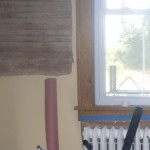Tight Warm Walls
We increased the R-value* of our walls by blowing dense-packed cellulose into the wall cavities, again using Performance Foam Insulation www.performancefoam.net. Dense-packed cellulose is blown in with greater pressure than old-fashioned loose-fill cellulose. Dense-packed cellulose more completely fills the stud cavities and doesn’t settle over time, leaving gaps. We chose this method because it delivers a higher R-value for a given wall thickness. It also resists air movement through the wall, which is critical in improving energy efficiency.
In our case, the dense-pack process cracked the plaster off some sections of some of our walls. We think this happened because our plaster is unusually thin in areas and the walls flexed. The lath didn’t come off, however, and the cellulose was contained. Fixing the holes was a little work, but well worth it for tight, warm walls.
We removed the damaged plaster and a little more to form rectangular-shaped gaps, then we screwed new ¼” or 3/8” drywall over the existing lath to bring the repair out to the level of the surrounding, undamaged plaster. We filled the gaps around the drywall with strong, non-shrinking setting-type joint compound, which comes in a powder and needs to be mixed with water. We embedded mesh joint tape in the wet compound. We applied subsequent coats of pre-mixed light-weight joint compound to make the repairs smooth and undetectable.
*R-value measures a material’s resistance to heat flow. A higher R-value means a better insulator.
